Roman Religion and Beliefs
The Romans and the religions of Britain
When the Romans invaded Britain in 43 AD, they found a country whose religion was based on local stories, superstitions and beliefs with no real order on consistency amongst the individual tribes. Their first port of call was the south east of England, which had a race that consisted of with their own beliefs and Belgic and Gallic people that had taken refuge in Britain. These immigrants had brought their own brand of worship with them.
The Romans were relaxed in their attitudes to the tribes, as they knew that their religion was fundamental to their existence. There was one tribe that the Romans despised because of their ways. This tribe was the Druids of Angelsey.
The Romans had become the sworn enemy of the Druids, claiming this was due to their barbaric sacrifices of humans at an altar. This attitude was kind of hypocritical in view of the legendary Roman gladiatorial battles and their treatment of the early Christians.
|
|
The Romans had two reasons for any action. The public statement of why their actions were justified, and the private political motives behind their stance. The Druids were no exception, and the Roman claim to justifiably wiping out this tribe on purely religious grounds was a a cover for their real motives.
The Druids had been driven out of Gaul and into Britain, then on to Angelsey by the advancing Roman army, acting under orders from the Emperor. The Druids had influential power in the Roman world, mostly because of the mystic fear that they installed in all those they encountered. They had become too vocal in matters of education and Roman politics and it was this that led to their persecution by the Romans.
Apart from Druidism, the remainder of the religions in Britain were largely untouched. Probably because the Romans knew that religion in Britain was regarded in very much the same way that it was in Rome. A basic fundamental principle of the way of life.
The introduction of Roman religion to Britain
One of the first acts that the new Roman government in Britain undertook was to introduce the Imperial cult to the island.
The Colchester Temple
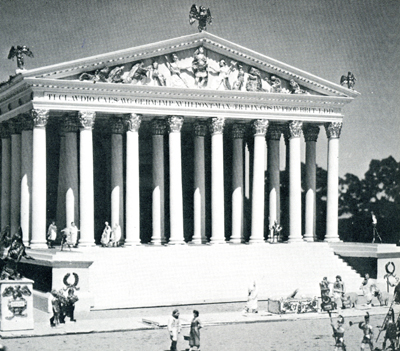 The first form that the introduction took was in the form of altar, a massive temple and a provincial centre in Colchester. Temples were usually dedicated to an emperor after he died, but what is unusual is that it commonly believed the temple at Colchester was dedicated to the Emperor Claudius while he was still alive. Why this happened is unclear, as Claudius had already spurned an attempt in Egypt to have him declared a god. But newer research has thrown light onto the matter and it is now generally agreed that the temple was not actually completed until after the death of Claudius.
The first form that the introduction took was in the form of altar, a massive temple and a provincial centre in Colchester. Temples were usually dedicated to an emperor after he died, but what is unusual is that it commonly believed the temple at Colchester was dedicated to the Emperor Claudius while he was still alive. Why this happened is unclear, as Claudius had already spurned an attempt in Egypt to have him declared a god. But newer research has thrown light onto the matter and it is now generally agreed that the temple was not actually completed until after the death of Claudius.
The temple was destroyed during the Boudiccan rebellion, but it must have been rebuilt, both out of Roman pride in their religion, and also to avoid the remains becoming a focal point for those sympathetic to the Boudiccan cause. It was a grand structure and many in Rome were impressed by it's magnificence
It was constructed in the best classical manner on a raised podium and with an octastyle portico approached by a flight of steps. In the courtyard stood the sacrificial altar, which had statues on either side.
The temple would not have been just a religious place, but also a center for many public ceremonies that would have been held in full view of the oversized statue of Claudius.
The structure of religion in Roman Britain
The imperial cult in Britain had an elected council that was chosen by the natives of the land. The council in turn nominated a chief priest whose duties were to arranges the ceremonies and festivities. The costs of this were met by the office holders. Tacitus records that before the Boudiccan rebellion, when civitas were few, the costs were met by a small band of people, and so this caused unrest amongst them. To ensure that a governor did not overspend, the council had the authority to communicate directly with Rome. This was rarely exercised, as the governor had spent a great deal of time and expense in elevating himself to his current position, and would not throw it away unnecessarily.
This council originally sat in the temple of Colchester, but it is believed that the cult had transferred to London (Londinium) by the end of the first century AD. This is entirely feasible, as, by this time, London had become the administrative capital for the whole country.
Along with the cult, came the official gods of the Roman religion, which are described below. These were introduced in the form of deities along with other abstract concepts such as Fate, Fortune and Victory.
Religion and the military
The military was the greatest observer of religious events and possessed a calendar detailing the dates and events that were to take place. These involved rituals and displays of faith, especially to the emperor and the god Jupiter. Each unit would erect a new altar to the deity on the edge of the parade ground. A time after the ceremonies were completed, the discarded pieces would be buried. They would also maintain a shrine which would hold the statutes relating to the military, and the Legion's standard when it was not being used. The rituals were observed meticulously by all involved, as it would be deemed an insult to the deity, so these ceremonies were taken most seriously.
The military was made up of Roman regulars and, as time went on, more and more recruits from the tribes. This led to a conflict of beliefs as those in the military who were native to Britain had their own gods and religious festivals to commemorate. Because the British tribal religions and the Roman beliefs were very much on a parallel, there was little trouble in integrating them into one common religion. The only religions that did not, and were not incorporated, were Christianity and Judaism. These religions were at odds with the accepted beliefs and were very much at a tangent to them, which was why they did not become integrated.
The fused religions
These fused religions were recognised by both the Romans and the British To the Romans it was a demonstration of the Romanisation of Britain, the interpretation Romana. To he British, it was an extension of their, already fragmented, beliefs.
Not all of Britain was under the same influence however. The further away from the built up towns, the stronger was the belief in the purely Celtic gods and ways.
The Mother Earth
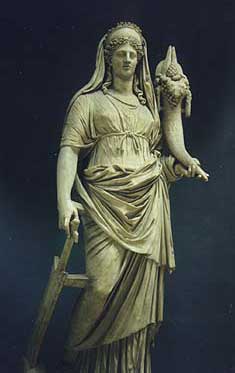
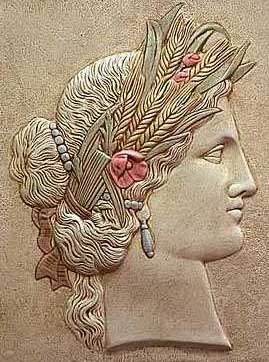 One of the most important Celtic beliefs that survived the transition and Romanisation process, was the cult that believed in a 'Mother Goddess' What we call today, a Mother Earth. In the Iron Age, this god was known as Ceres. She was worshiped by a fertility cult, and as fertility was so important to the Celts, she was perceived as being all powerful and often portrayed in a triple, and sometimes quadruple form.
One of the most important Celtic beliefs that survived the transition and Romanisation process, was the cult that believed in a 'Mother Goddess' What we call today, a Mother Earth. In the Iron Age, this god was known as Ceres. She was worshiped by a fertility cult, and as fertility was so important to the Celts, she was perceived as being all powerful and often portrayed in a triple, and sometimes quadruple form.
In these religions, the number three had a mystical importance and was used to denote the power of the deity. In Britain, the cult of the Matres was widespread and at Cirencester and Bath, the cult took the tile of the Sulevian Mothers. On one sculpture, they appear as three stern looking matrons sitting upright on a bench, nursing baskets containing loaves and fruit.
The cult of Mithras
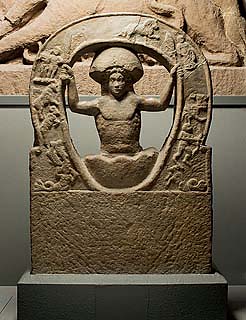 Stone relief from Housesteads showing the birth of the god Mithras from an egg – the symbol of eternal time |
Being superstitious people, both the Romans and Celts held religion in high esteem, so any cults that appeared were approached with apprehension. One of the most mysterious religions was the cult of Mithras,which was different from other religions in that it required it's followers to live their lives by a moral code. Entrants to Mithraism had to perform a series initiation tests that would test both physical and moral standards. Mithraism had many different initiation tests and depending on how well the applicant performed in these tests determined the grade that they were rewarded with. There were many grades such as Lion, Raven, Bridegroom, Soldier, Father, which were decided by undergoing tests involving ordeals by fire, water or fasting.
The cult of Mithras originated in Persia where it was known as Ahuramazda. This deity was depicted as fighting a constant battle against good and evil which was depicted as the power of light against darkness. In this constant battle, Mithras was aided by two torch carrying acolytes, Cautes and Cautopates who represented twilight and dawn. The religion is surrounded in mystery and was not east to understand due to it's complex nature.
Understandably, the main recruits into the cult were soldiers and merchants, probably two of the most superstitious classes in society. The group of Mithraea knew this and so concentrated their teachings and bases where they could influence the greatest number of potential converts.
London was the main centre for Mithraism as this was were the greatest congregation of merchants and military could be found., though there have been instances of inscriptions and images of Mithras found at Caernarfon, Housesteads, Carrawburgh which shows that the religion was very widespread across Britain.
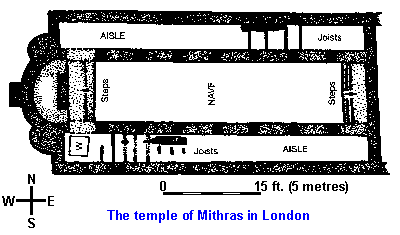
The temples were usually quite small, rectangular in shape and often had a small apse at one end. The London temple had this apse, while the temple at Carrawburgh had a recess, so they were not entirely uniform in their design. The temple was usually divided into three rows with the centre row serving as an aisle.
The Rise of Christianity
At the same time as Mithraism was gaining momentum, so Christianity was increasing in strength. Both religions had the common factor that both had foundations in countries outside the Roman Empire and it was many years before they became known in Britain. Whereas Mithraism was accepted by the Roman world, Christianity was not and was the subject of extreme persecution by the Romans. This was due to the refusal of the Christians to swear allegiance to the Roman emperor. The Mithras followers did take the oath. and therefore were accepted into Roman society. The Romans saw the Christian refusal to take the oath not as a religious insult, but as one on the Roman state in general. This was treason, a view that made the Romans believe the persecution of all Christians as right and proper.
The Romans were also suspicious of people who formed groups, for whatever purpose. Any association was monitored closely any group that was seen to congregate too often was interviewed at length.
Before the Edict of Toleration in 313 AD, little is known of Christianity in Roman Britain, but there is an interesting inscription that was found in Cirencester that had been carefully scratched onto the painted surface of the wall plaster, which dates back to the second or third century.
|
|
|
|
|
|
|
|
|
|
|
|
|
|
|
|
|
|
|
|
|
|
|
|
|
|
|
|
|
|
Translated it means 'The sower Arepo guides the wheels carefully'.
Symbolically, the wheel can be translated as a reference to eternal life. But if all the letters are rearranged, they spell the work 'PATERNOSTER', which are the opening words of the Lords' prayer with two A's and two O's left. In early Christian symbolism AO meant Alpha and Omega, the beginning and the end, the first and last letters of the Greek alphabet. The beginning and the end of the revelation of St. John.
Only a year after the edict had been issued, no less than three bishops, the metropolitans of London, Lincoln and York together with, possibly Cirencester, attended a council of the Church of Arles. So it appears likely that the Christian church had been organised for some time before 313 AD.
In the fourth century, there is much more evidence in the form of the chi-cho (which looks like a cross with the letter 'P' vertically through the centre) appearing on as a monogram on personal possessions. This symbol s made up of the first two letters of the Greek work Christos.
The Roman Gods
Fortuna
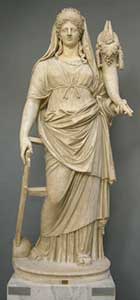 Fortuna was the goddess of fortune and the personification of luck in Roman religion. Fortuna is frequently shown on military inscriptions, such as distance slabs on the Antonine Wall. In legionary bathhouses she protected soldiers against the evil eye (and perhaps also contributed to their success in dice games).
Fortuna was the goddess of fortune and the personification of luck in Roman religion. Fortuna is frequently shown on military inscriptions, such as distance slabs on the Antonine Wall. In legionary bathhouses she protected soldiers against the evil eye (and perhaps also contributed to their success in dice games).
Fortuna is often depicted with a gubernaculum (ship's rudder), a ball or Rota Fortunae (wheel of fortune) and a cornucopia (horn of plenty). She might bring good or bad luck: she could be represented as veiled and blind, as in modern depictions of Lady Justice, and came to represent life's capriciousness. She was also a goddess of fate: as Atrox Fortuna, she claimed the young lives of the princeps Augustus' grandsons Gaius and Lucius, prospective heirs to the Empire.
Her father was said to be Jupiter and like him, she could also be bountiful (Copia). As Annonaria she protected grain supplies. June 11 was sacred to her: The date of dedication of her temples was 24 June, or Midsummer’s Day, when celebrants from Rome annually floated to the temples downstream from the city. After undisclosed rituals they then rowed back, garlanded and inebriated. Also Fortuna had a temple at the Forum Boarium. Here Fortuna was twinned with the cult of Mater Matuta (the goddesses shared a festival on 11 June), and the paired temples have been revealed in the excavation beside the church of Sant'Omobono: the cults are indeed archaic in date. Fortuna Primigenia of Praeneste was adopted by Romans at the end of 3rd century BC in an important cult of Fortuna Publica Populi Romani (the Official Good Luck of the Roman People) on the Quirinalis outside the Porta Collina. No temple at Rome, however, rivalled the magnificence of the Praenestine sanctuary.
Fortuna's identity as personification of chance events was closely tied to virtus (strength of character). Public officials who lacked virtues invited ill-fortune on themselves and Rome: Sallust uses the infamous Catiline as illustration – "Truly, when in the place of work, idleness, in place of the spirit of measure and equity, caprice and pride invade, fortune is changed just as with morality".
An oracle at the Temple of Fortuna Primigena in Praeneste used a form of divination in which a small boy picked out one of various futures that were written on oak rods. Cults to Fortuna in her many forms are attested throughout the Roman world. Dedications have been found to Fortuna Dubia (doubtful fortune), Fortuna Brevis (fickle or wayward fortune) and Fortuna Mala (bad fortune).
She is found in a variety of domestic and personal contexts. During the early Empire, an amulet from the House of Menander in Pompeii links her to the Egyptian goddess Isis, as Isis-Fortuna.She is functionally related to the god Bonus Eventus,who is often represented as her counterpart: both appear on amulets and intaglio engraved gems across the Roman world. In the context of the early republican period account of Coriolanus, in around 488 BC the Roman senate dedicated a temple to Fortuna on account of the services of the matrons of Rome in saving the city from destruction.Evidence of Fortuna worship has been found as far north as Castlecary, Scotland and an altar and statue can now be viewed at the Hunterian Museum in Glasgow.
Hercules
 Hercules is a Roman hero and god. He was the son of Jupiter and the mortal Alcmene. In classical mythology, Hercules is famous for his strength and for his numerous far-ranging adventures. Primarily a soldier's god of strength and virility, was also popular in civilian settlements. In Britain he was associated with the Celtic god Saegon ("all-conquering") and was also a healing deity.
Hercules is a Roman hero and god. He was the son of Jupiter and the mortal Alcmene. In classical mythology, Hercules is famous for his strength and for his numerous far-ranging adventures. Primarily a soldier's god of strength and virility, was also popular in civilian settlements. In Britain he was associated with the Celtic god Saegon ("all-conquering") and was also a healing deity.
Hercules had a number of myths that were distinctly Roman. One of these is Hercules' defeat of Cacus, who was terrorizing the countryside of Rome. The hero was associated with the Aventine Hill through his son Aventinus. Mark Antony considered him a personal patron god, as did the emperor Commodus. Hercules received various forms of religious veneration, including as a deity concerned with children and childbirth, in part because of myths about his precocious infancy, and in part because he fathered countless children. Roman brides wore a special belt tied with the "knot of Hercules", which was supposed to be hard to untie. During the Roman Imperial era, Hercules was worshipped locally from Hispania through Gaul.
Jupiter
 Jupiter was normally depicted as a powerful bearded figure with a thunderbolt and eagle, he was essentially a sky divinity and the head of the Roman pantheon. He was invoked each year at forts as "Jupiter Best and Greatest" (luppiter Optimus Maximus).
Jupiter was normally depicted as a powerful bearded figure with a thunderbolt and eagle, he was essentially a sky divinity and the head of the Roman pantheon. He was invoked each year at forts as "Jupiter Best and Greatest" (luppiter Optimus Maximus).
Jupiter was the god of the sky and thunder and king of the gods in Ancient Roman religion and mythology. Jupiter was the chief deity of Roman state religion throughout the Republican and Imperial eras, until Christianity became the dominant religion of the Empire. In Roman mythology, he negotiates with Numa Pompilius, the second king of Rome, to establish principles of Roman religion such as offering, or sacrifice. Sacrificial victims (hostiae) offered to Jupiter were the ox (castrated bull), the lamb (on the Ides, the ovis idulis) and the wether (on the Ides of January). The animals were required to be white. The question of the lamb's gender is unresolved; while a lamb is generally male, for the vintage-opening festival the flamen Dialis sacrificed a ewe. This rule seems to have had many exceptions, as the sacrifice of a ram on the Nundinae by the flaminica Dialis demonstrates. During one of the crises of the Punic Wars, Jupiter was offered every animal born that year.
Jupiter's identifying implement is the thunderbolt and his primary sacred animal is the eagle, which held precedence over other birds in the taking of auspices and became one of the most common symbols of the Roman army. The two emblems were often combined to represent the god in the form of an eagle holding in its claws a thunderbolt, frequently seen on Greek and Roman coins. As the sky-god, he was a divine witness to oaths, the sacred trust on which justice and good government depend. Many of his functions were focused on the Capitoline Hill, where the citadel was located. He was the chief deity of the early Capitoline Triad with Mars and Quirinus. In the later Capitoline Triad, he was the central guardian of the state with Juno and Minerva. His sacred tree was the oak.
The Romans regarded Jupiter as the equivalent of the Greek Zeus, and in Latin literature and Roman art, the myths and iconography of Zeus are adapted under the name Iuppiter. In the Greek-influenced tradition, Jupiter was the brother of Neptune and Pluto, the Roman equivalents of Poseidon and Hades respectively. Each presided over one of the three realms of the universe: sky, the waters, and the underworld. The Italic Diespiter was also a sky god who manifested himself in the daylight, usually but not always identified with Jupiter. Tinia is usually regarded as his Etruscan counterpart.
The Romans believed that Jupiter granted them supremacy because they had honoured him more than any other people had. Jupiter was "the fount of the auspices upon which the relationship of the city with the gods rested."[9] He personified the divine authority of Rome's highest offices, internal organization, and external relations. His image in the Republican and Imperial Capitol bore regalia associated with Rome's ancient kings and the highest consular and Imperial honours.
The consuls swore their oath of office in Jupiter's name, and honoured him on the annual feriae of the Capitol in September. To thank him for his help (and to secure his continued support), they offered him a white ox (bos mas) with gilded horns. A similar offering was made by triumphal generals, who surrendered the tokens of their victory at the feet of Jupiter's statue in the Capitol. Some scholars have viewed the triumphator as embodying (or impersonating) Jupiter in the triumphal procession.
Mars
 Mars was originally a god of agriculture, then became the Roman war god. Popular in Britain, he was associated with a number of Celtic war deities, some (Belatucadrus, Alator, Condates) unique to Britain, others (Camulos and Toutates) also appearing on the continent. Mars was also linked to healing gods such as Nodens and Lenus. Mars was the god of war and also an agricultural guardian, a combination characteristic of early Rome. He was second in importance only to Jupiter and he was the most prominent of the military gods in the religion of the Roman army. Most of his festivals were held in March, the month named for him (Latin Martius), and in October, which began the season for military campaigning and ended the season for farming.
Mars was originally a god of agriculture, then became the Roman war god. Popular in Britain, he was associated with a number of Celtic war deities, some (Belatucadrus, Alator, Condates) unique to Britain, others (Camulos and Toutates) also appearing on the continent. Mars was also linked to healing gods such as Nodens and Lenus. Mars was the god of war and also an agricultural guardian, a combination characteristic of early Rome. He was second in importance only to Jupiter and he was the most prominent of the military gods in the religion of the Roman army. Most of his festivals were held in March, the month named for him (Latin Martius), and in October, which began the season for military campaigning and ended the season for farming.
Under the influence of Greek culture, Mars was identified with the Greek god Ares, whose myths were reinterpreted in Roman literature and art under the name of Mars. But the character and dignity of Mars differed in fundamental ways from that of his Greek counterpart, who is often treated with contempt and revulsion in Greek literature. Mars was a part of the Archaic Triad along with Jupiter and Quirinus, the latter of whom, as a guardian of the Roman people, had no Greek equivalent. Mars' altar in the Campus Martius, the area of Rome that took its name from him, was supposed to have been dedicated by Numa, the peace-loving semi-legendary second king of Rome. Although the center of Mars' worship was originally located outside the sacred boundary of Rome (pomerium), Augustus made the god a renewed focus of Roman religion by establishing the Temple of Mars Ultor in his new forum.
Although Ares was viewed primarily as a destructive and destabilizing force, Mars represented military power as a way to secure peace, and was a father (pater) of the Roman people. In the mythic genealogy and founding myths of Rome, Mars was the father of Romulus and Remus with Rhea Silvia. His love affair with Venus symbolically reconciled the two different traditions of Rome's founding; Venus was the divine mother of the hero Aeneas, celebrated as the Trojan refugee who "founded" Rome several generations before Romulus laid out the city walls.
The importance of Mars in establishing religious and cultural identity within the Roman Empire is indicated by the vast number of inscriptions identifying him with a local deity, particularly in the Western provinces.
Mercury
 Mercury was he Roman messenger god and patron of commerce has dozens of representations in Britain where, as in Gaul, he was often syncretized with local Celtic deities. As Caesar remarks in the Commentaries on the Gallic Wars (Bk 6, chap. 17), "They have many images of Mercury, and regard him as the inventor of all arts . . . and to have very great influence over the acquisition of gain and mercantile transactions."
Mercury was he Roman messenger god and patron of commerce has dozens of representations in Britain where, as in Gaul, he was often syncretized with local Celtic deities. As Caesar remarks in the Commentaries on the Gallic Wars (Bk 6, chap. 17), "They have many images of Mercury, and regard him as the inventor of all arts . . . and to have very great influence over the acquisition of gain and mercantile transactions."
Mercury (Latin: Mercurius) was a major Roman god, being one of the Dii Consentes within the ancient Roman pantheon. He is the patron god of financial gain, commerce, eloquence (and thus poetry), messages/communication (including divination), travelers, boundaries, luck, trickery and thieves; he is also the guide of souls to the underworld. He was considered the son of Maia and Jupiter in Roman mythology.
Mercury was the "keeper of boundaries," referring to his role as bridge between the upper and lower worlds. In his earliest forms, he appears to have been related to the Etruscan deity Turms; both gods share characteristics with the Greek god Hermes. He is often depicted holding the caduceus in his left hand. Similar to his Greek equivalent (Hermes) he was awarded the caduceus by Apollo who handed him a magic wand, which later turned into the caduceus.
From the beginning, Mercury had essentially the same aspects as Hermes, wearing winged shoes (talaria) and a winged hat (petasos), and carrying the caduceus, a herald's staff with two entwined snakes that was Apollo's gift to Hermes. He was often accompanied by a cockerel, herald of the new day, a ram or goat, symbolizing fertility, and a tortoise, referring to Mercury's legendary invention of the lyre from a tortoise shell.
Like Hermes, he was also a god of messages, eloquence and of trade, particularly of the grain trade. Mercury was also considered a god of abundance and commercial success, particularly in Gaul, where he was said to have been particularly revered. He was also, like Hermes, the Romans' psychopomp, leading newly deceased souls to the afterlife. Additionally, Ovid wrote that Mercury carried Morpheus' dreams from the valley of Somnus to sleeping humans.
In Brtiannia
When they described the gods of Celtic and Germanic tribes, rather than considering them separate deities, the Romans interpreted them as local manifestations or aspects of their own gods, a cultural trait called the interpretatio Romana. Mercury, in particular, was reported as becoming extremely popular among the nations the Roman Empire conquered; Julius Caesar wrote of Mercury being the most popular god in Britain and Gaul, regarded as the inventor of all the arts. This is probably because, in the Roman syncretism, Mercury was equated with the Celtic god Lugus, and in this aspect was commonly accompanied by the Celtic goddess Rosmerta. Although Lugus may originally have been a deity of light or the sun (though this is disputed), similar to the Roman Apollo, his importance as a god of trade made him more comparable to Mercury, and Apollo was instead equated with the Celtic deity Belenus.
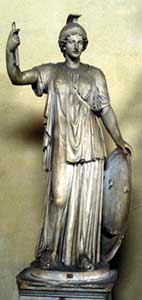 Minerva was the Roman goddess of wisdom and artisans, was also a deity of war and patroness of the clerical staff of the Roman army. At Bath, where she was merged with the local water deity Sulis, a dedication was made to her by Roman engineers who built the temple.
Minerva was the Roman goddess of wisdom and artisans, was also a deity of war and patroness of the clerical staff of the Roman army. At Bath, where she was merged with the local water deity Sulis, a dedication was made to her by Roman engineers who built the temple.
Minerva was the Roman goddess of wisdom and strategic warfare, and the sponsor of arts, trade, and strategy. From the second century BC onward, the Romans equated her with the Greek goddess Athena.
Following the Greek myths around Athena, she was born of Metis, who had been swallowed by Jupiter, and burst from her father's head, fully armed and clad in armor. After impregnating the titaness Metis, Jupiter recalled a prophecy that his own child would overthrow him.
Fearing that their child would grow stronger than he was and rule the Heavens in his place, Jupiter swallowed Metis whole. The titaness gave birth to Minerva nonetheless and forged weapons and armor for her child while within Jupiter's body. The constant pounding and ringing gave him a headache. To relieve the pain, Vulcan used a hammer to split Jupiter's head and, from the cleft, Minerva emerged, whole, adult, and bearing her mother's weapons and armor.
She was the virgin goddess of music, poetry, medicine, wisdom, commerce, weaving, and the crafts. She is often depicted with her sacred creature, an owl usually named as the "Owl of Minerva", which symbolised her association with wisdom and knowledge.
Minerva was worshipped at several locations in Rome, including most prominently as part of the Capitoline Triad, and also at the Temple of Minerva Medica, and at the "Delubrum Minervae", a temple founded around 50 BC by Pompey on the site now occupied by the church of Santa Maria sopra Minerva.
The Romans celebrated her festival from March 19 to March 23 during the day which is called, in the neuter plural, Quinquatria, the fifth after the Ides of March, the nineteenth, an artisans' holiday. A lesser version, the Minusculae Quinquatria, was held on the Ides of June, June 13, by the flute-players, who were particularly useful to religion. In 207 BC, a guild of poets and actors was formed to meet and make votive offerings at the temple of Minerva on the Aventine Hill. Among others, its members included Livius Andronicus. The Aventine sanctuary of Minerva continued to be an important center of the arts for much of the middle Roman Republic.
As Minerva Medica, she was the goddess of medicine and physicians. As Minerva Achaea, she was worshipped at Lucera in Apulia where votive gifts and arms said to be those of Diomedes were preserved in her temple.
Her worship also was spread throughout the empire. In Britain, for example, she was syncretized with the local goddess Sulis, who often was invoked for restitution for theft.
In Fasti III, Ovid called her the "goddess of a thousand works". Minerva was worshipped throughout Italy, and when she eventually became equated with the Greek goddess Athena, she also became a goddess of battle. Unlike Mars, god of war, she was sometimes portrayed with sword lowered, in sympathy for the recent dead, rather than raised in triumph. In Rome her bellicose nature was emphasized less than elsewhere.
Silvanus
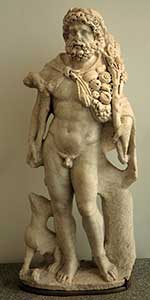 Silvanus was originally an agricultural god and a variant of Mars, presided over fertility, forestry, farming, land-clearing, and the prosperity of cattle. He lived in forests and mountains. Altars to Silvanus occur at many British sites, mostly in the north.
Silvanus was originally an agricultural god and a variant of Mars, presided over fertility, forestry, farming, land-clearing, and the prosperity of cattle. He lived in forests and mountains. Altars to Silvanus occur at many British sites, mostly in the north.
Silvanus (meaning "of the woods" in Latin) was a Roman tutelary deity of woods and fields. As protector of forests (sylvestris deus), he especially presided over plantations and delighted in trees growing wild. He is also described as a god watching over the fields and husbandmen, protecting in particular the boundaries of fields. The similarly named Etruscan deity Selvans may be a borrowing of Silvanus, or not even related in origin.
Silvanus is described as the divinity protecting the flocks of cattle, warding off wolves, and promoting their fertility. Dolabella, a rural engineer of whom only a few pages are known, states that Silvanus was the first to set up stones to mark the limits of fields, and that every estate had three Silvani
Like other gods of woods and flocks, Silvanus is described as fond of music; the syrinx was sacred to him, and he is mentioned along with the Pans and Nymphs. Later speculators even identified Silvanus with Pan, Faunus, Inuus and Aegipan. He must have been associated with the Italian Mars, for Cato refers to him as Mars Silvanus. In the provinces outside of Italy, Silvanus was identified with numerous native gods:
The sacrifices offered to Silvanus consisted of grapes, ears of grain, milk, meat, wine and pigs. In Cato's De Agricultura an offering to Mars Silvanus is described, to ensure the health of cattle; it is stated there that his connection with agriculture referred to only the labour performed by men, and that females were excluded from his worship. (Compare Bona Dea for a Roman deity from whose worship men were excluded.) Virgil relates that in the very earliest times the Tyrrhenian Pelasgians had dedicated a grove and a festival to Silvanus.
The Genii
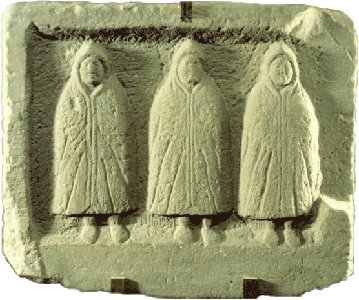 The Genii were abstract powers or spirits of individual places or people. They are commonly represented holding a cornucopia and patera over an altar, such as in a genius loci.
The Genii were abstract powers or spirits of individual places or people. They are commonly represented holding a cornucopia and patera over an altar, such as in a genius loci.
is the individual instance of a general divine nature that is present in every individual person, place, or thing. Much like a guardian angel, the genius would follow each man from the hour of his birth until the day he died.[2] For women, it was the Juno spirit that would accompany each of them.
Each individual place had a genius (genius loci) and so did powerful objects, such as volcanoes. The concept extended to some specifics: the genius of the theatre, of vineyards, and of festivals, which made performances successful, grapes grow, and celebrations succeed, respectively. It was extremely important in the Roman mind to propitiate the appropriate genii for the major undertakings and events of their lives.
Although the term genius might apply to any divinity whatsoever, most of the higher-level and state genii had their own well-established names. Genius applied most often to individual places or people not generally known; that is, to the smallest units of society and settlements, families and their homes. Houses, doors, gates, streets, districts, tribes, each one had its own genius. The supreme hierarchy of the Roman gods, like that of the Greeks, was modelled after a human family. It featured a father, Jupiter, who was also the supreme divine unity, and a mother, Juno, queen of the gods. These supreme unities were subdivided into genii for each individual family; hence, the genius of each female, representing the female domestic reproductive power, was a Juno. The male function was a Jupiter.
The juno was worshipped under many titles:
- Iugalis, "of marriage"
- Matronalis, "of married women"
- Pronuba, "of brides"
- Virginalis, "of virginity"
Genii were often viewed as protective spirits, as one would propitiate them for protection. For example, to protect infants one propitiated a number of deities concerned with birth and childrearing: Cuba ("lying down to sleep"), Cunina ("of the cradle") and Rumina ("of breast-feeding"). Certainly, if those genii did not perform their proper function well, the infant would be in danger.
Hundreds of lararia, or family shrines, have been discovered at Pompeii, typically off the atrium, kitchen or garden, where the smoke of burnt offerings could vent through the opening in the roof. A lararium was distinct from the penus ("within"), another shrine where the penates, gods associated with the storerooms, was located. Each lararium features a panel fresco containing the same theme: two peripheral figures (Lares) attend on a central figure (family genius) or two figures (genius and Juno) who may or may not be at an altar. In the foreground is one or two serpents crawling toward the genius through a meadow motif. Campania and Calabria preserved an ancient practice of keeping a propitious house snake, here linked with the genius. In another, unrelated fresco (House of the Centenary) the snake-in-meadow appears below a depiction of Mount Vesuvius and is labelled Agathodaimon, "good daimon", where daimon must be regarded as the Greek equivalent of genius.
Dedications to Near Eastern Gods, including Mithras, Cybele, Atys, Isis, Serapis, and Sol Invictus have been found in London, York, and many other settlements.
Cybele, a mother goddess, originated in Phrygia (now Turkey). Her cult, introduced to Rome in 205 BC, was legalized by Claudius. Atys was her shepherd consort, each year reborn as part of a fertility ritual. Also associated with bull sacrifice was Mithras, an Indo-Iranian sun god. In the mid-3rd century AD, another sun god, Sol Invictus was endorsed by Aurelian.




















